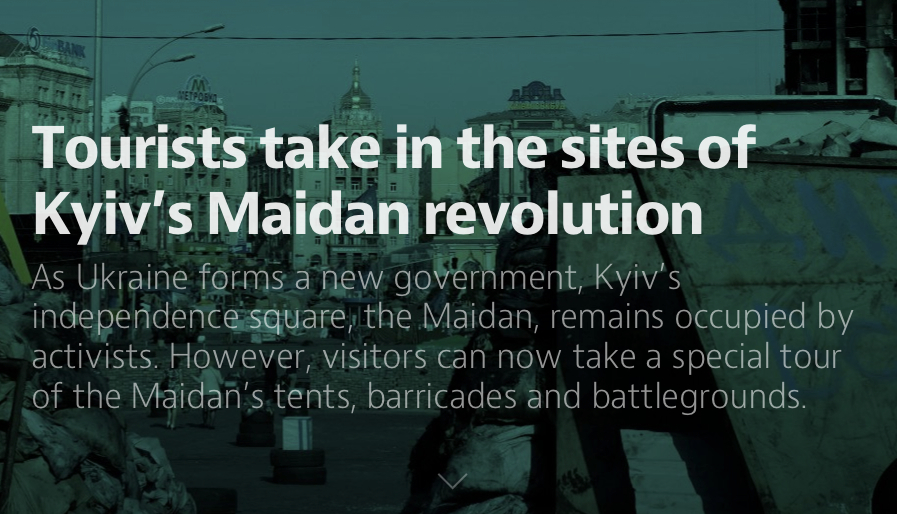Using Medium for online journalism training
![]() Encouraging trainees to use a blog platform such as WordPress, Blogger or Tumblr is a common approach in online journalism training.
Encouraging trainees to use a blog platform such as WordPress, Blogger or Tumblr is a common approach in online journalism training.
The benefits in training workshops are numerous:
– most blog platforms are free to use and useful for training the basics of writing for the web;
– a blog post can replicate a standard online article;
– a blog is an easy to use, creative digital space;
– trainees can experiment with embedding multimedia and even adjusting html code;
– and, particularly for print journalists moving to digital media, the CMS of a blog often functions in a similar way to the CMS of a news media website.
However, if you’ve ever shown trainees examples of scrolling style stories such as the NYT’s Game of Sharks and Minnows or the Guardian’s Firestorm, you’ll often hear the question: how can we produce the scrolling style, especially for long form writing such as magazine style feature stories?
I usually point out the obvious, explaining that blogs do in fact let you scroll down the page. And depending on the level of experience of the participants, I might also suggest storytelling applications that onMedia has tested such as Creatavist.
But more so these days, particularly if I’m training short workshops, I like to introduce trainees to Medium – the blog platform developed by Blogger and Twitter founder Evan Williams.
Why Medium for training?
Using Medium, trainees get simple, yet very visually pleasing results, very quickly. And that can be hugely beneficial when trying to get your workshop participants enthusiastic about experimenting with new ways of storytelling.
Medium offers a simple blog design that lends itself to long format writing. Think magazine style features for example. You could say it does one thing very well. If your trainees have a story that observes the basics of good writing for the web and includes at least one strong image, then Medium’s design and layout enables them to produce a visually attractive piece, fast.
Opening an account is free and easy. All trainees need to do is log-in with a Twitter or Facebook account and literally start writing.
If all goes well you’ll usually hear a few “Aha’s!” and see some smiles from participants as they start to add text and images and scroll down their story.
Working in the Medium editor is very much WYSIWYG (what you see is what you get). You immediately see what your story is going to look like. There’s no going back and forth between edit and preview/publish modes as I’m doing right now writing this post on WordPress.
Embedding images or other shareable media such as video, audio, tweets or ThingLink images is straightforward – just a quick cut and paste of the hyperlink or html code into the desired location marked with a ⊕ will bring up the embed options.
Saving is automated (see top left of page in editing mode) which hopefully should mean no tears in class because someone has lost their work.
Medium also uses fonts that are well suited to reading on the web and mobile displays: FF Meta Serif and Myriad. Some might argue that’s a limitation, but it does mean you’re less likely to have a workshop participant publish their story in something completely inappropriate such as ComicSans!
Once you’ve published your story, you can group stories together under collections. For workshops, this is a useful function as you can make a collection of everyone’s stories. Don’t forget to add tags which make it easier for a story to be discovered and read by other users on Medium. It is after all a community of users that appreciate good writing.
And, Medium stories can be embedded into other websites and most blogs. Click on the example below and scroll down to find the embed option “…”at the bottom right of the story.
Keeping it simple
Medium is not a blog platform that you can customize with all the bells and whistles such as WordPress.
It’s not going to appeal to everyone, nor will it lend itself to every type of story.
But what Medium excels at doing is providing a simple editing interface and publishing platform. For more advanced trainees (there’s always one!) with a good knowledge of HMTL, Svblte might be appealing as an alternative blog platform to Medium that offers a similar clean magazine style of design and layout.
As with all free to use platforms, it’s worth reminding your trainees that a change in ownership or lack of funding could result in the service being discontinued and their precious work disappearing. (It does happen – Posterous was a popular blog site that had its demise in 2013). From the settings, you can export Medium stories as a zip file.
Author: Guy Degen




